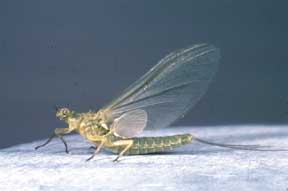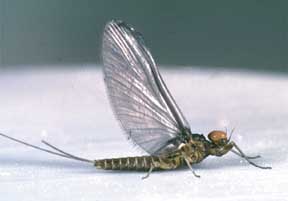
![]()
Trips
Montana
Missouri
Beaverhead & Big Hole
SW
Montana
Clark Fork & Bitterroot
Bahamas
Andros Island
Upper Delaware
Other Destinations
Alaska
New Zealand
Argentina
Chile
![]()
News
![]()
River Updates
Hatch
Chart
![]()
Campground
![]()
Tips
Articles
ACFF
Photo Gallery
![]()
Al Caucci's Biography
Testimonials
![]()
Contact Us
Home
![]()
Your fishing logs at Ecolure
![]()
Friends of the
Upper
Delaware
![]()
1250 Winterdale Road
Starlight, PA, 18461
Phone : 1 ( 570 ) 635 - 5897
email : alcaucci@hancock.net

|
||||||||
|
Late Spring and Summer Hatches By Al Caucci During the exciting June period, the eastern angler can expect heavy hatches of sulphurs (Ephemerella invaria, rotunda and dorothea) ranging in size from #14 to #18, large isonychia mayflies, and the spectacular hatching and spinner activity of the big green and brown drakes (Ephemera guttulata and simulans). The midwestern angler has an abundance of both sulphur and isonychia mayfly hatches, but is also blessed with the truly awesome hatches of the giant Hexagenia limbata. The midwestern angler also has the prolific activity of brown drakes (Ephemera simulans). During this period, the water temperatures on freestone rivers ranges between 58 degrees F. and 65 degrees F., driving the trout to their metabolic peak. Hatching begins subtly in the mornings, and ends with a wild, heavy burst at twilight. During the day, Stenonema Cahills, Ephemera drakes, and Hex duns hatch sporadically. Their sparseness, together with their large size and fumbling efforts to take flight, create sporadic feeding activity. Trout generally are not very selective during this time, but good presentation is necessary, especially on sunny days when trout are spooky.
Sulphurs create steady, selective feeding from early evening into dark. Trout are usually very selective during this hatch. On cloudy days, or during inclement weather, the best activity may take place in the afternoon. During heat waves, this action may occur in the morning, evening, and well into dark. June is also the time for the giant stoneflies, such as the eastern salmon fly (Pteranarcys dorsata), the great brown stone (perla), and the willowfly (acroneuria). Also, there are wonderfully prolific hatches of hydropsche and glossosoma caddisflies that trigger excellent feeding activity. Anglers must carry with them a wide variety of pattern types, not only to match the variety of naturals, but also for the various insect stages: nymph, emerger, pupa, dun and spinner. At twilight, heavy spinner flights may resemble living blizzards, causing the well fed trout to become super selective. It's not unusual for species of mayflies and caddis to be emerging simultaneously. Trout are selective to the species and stage of the dominate insects, and the correct imitation is imperative for consistent success. Observation is the key. Check the size, color, and stage of the various insects, and match them with the proper imitations. The western hatches of summer begin with a crazy flurry of mayflies, caddis and stoneflies. Super hatches, like the salmon fly, golden stonefly, western green drake, flav, gray drake, and the hydropsyche caddis flies, are prevalent throughout the Rockies, Sierras, and Cascades in June and July (see "Match The Hatch" in the March/April issue for more information on this activity-Ed.) From mid July throughout the summer, most western rivers are very productive, especially those rich, cold, tailwater rivers, like the Henry's Fork of the Snake, Madison, Big Horn, Missouri (below Holter Dam), and the Dechutes. Also great are the Clark Fork, Blackfoot, Bitterroot, and Rock Creek, in the Missoula area of Montana, which are less influenced by cold bottom release tailwaters.
The summertime staples on all these rich rivers are the size 16 and 18 pale morning duns (Ephemerella infrequens and inermis), tricos in sizes 24 to 28, tiny blue winged olives (psuedocloeon, sizes 20 to 26), and heavy hydropsyche caddis in sizes 14 to 20. During the summer months, the western rivers continue to produce ideal water temperatures and prolific activity, due to their altitude, glacial influences, and innumerable springs, but in many cases it is due to the large number of blue ribbon tailwater rivers. Around the 4th of July, most eastern and midwestern free stone rivers may lose over 70% of their volume, raising the water temperatures well into the 70's, and making it difficult for both trout and trout fishermen. The AuSable and Pere Marquette in Michigan, and the Namekagon in Wisconsin, are just a few rivers that fish well throughout the summer. Wisconsin, Michigan, and the Upper Peninsula of Michigan all have many excellent spring fed streams and rivers that produce great hatches throughout the summer. Pennsylvania, New York, and New England have many trout streams that are also excellent throughout the summer. Famous small limestone streams in southeastern Pennsylvania, like Big Spring and Falling Spring, have excellent trico hatches. The larger spring creeks of central Pennsylvania all have superb hatches of tiny tricos and blue-winged olives, as well as late season caddis, plus scuds and cressbugs. The Northeast and Southeast have a number of tailwaters that produce great summer hatches, from the Upper Delaware river tailwaters in Pennsylvania and New York, to those southern Appalachian gems, the Watauga and South Holston. The Upper Delaware has two tail-waters, the East Branch in New York and the West Branch, which forms the border between New York and Pennsylvania. This is big, wild trout water, with over 100 miles of fishable length. The crown jewel of this system is the West Branch, which flows out of the Cannonsville reservoir. Mandatory, ice cold releases during June, July and August keep the river in the mid-50 degree F. range all summer long. The constant release affects the entire length of the West Branch, and 20 miles of the main stem. Transmitters planted in over 50 wild trout between 15- and 25-inches in length show that the wild browns and rainbows from the lower East Branch and main stem migrate to the colder West Branch and upper main stem when the water begins to warm up during hot spells. The West Branch and upper main stem sustain prolific hatches of size 24 to 28 tricos, size 20 to 28 blue-winged olives, small (size 18 to 20) sulphurs, size 14 to 16 light Cahills, and large (size 12 - 4X long) isonychia mayflies, plus late stoneflies, hydropsyche and limnephilis caddis flies that range from size 8-4X long to a small size 20. The tailwater phenomenon, which became prevalent in this country over 30 years ago, has been controversial. Yet, no one can deny that approximately 75% of the top trout rivers in the country today are tailwaters. So forget about the old tradition of trout fishing season being mainly in the spring. Grab your rod, don your waders and go fishing this summer!
|
||||||||


